Many aquarists go through the ordeal of sudden snail appearances. And more often than not, they’re left wondering how it happened. How exactly do snails suddenly appear in fish tanks; it can’t be magic, right?
Snails appear in a fish tank because you put them there, knowingly or unknowingly. When you add new fishes and plants to your aquarium, they sometimes have snail eggs attached to them. These aren’t visible to the naked eye. In time, however, they’re fully grown snails infesting your aquarium.
This article navigates the appearance of snails in a fish tank in detail. You’ll learn how to deal with a snail infestation and many other things. Read on!
Can Snails Just Appear in a Fish Tank?
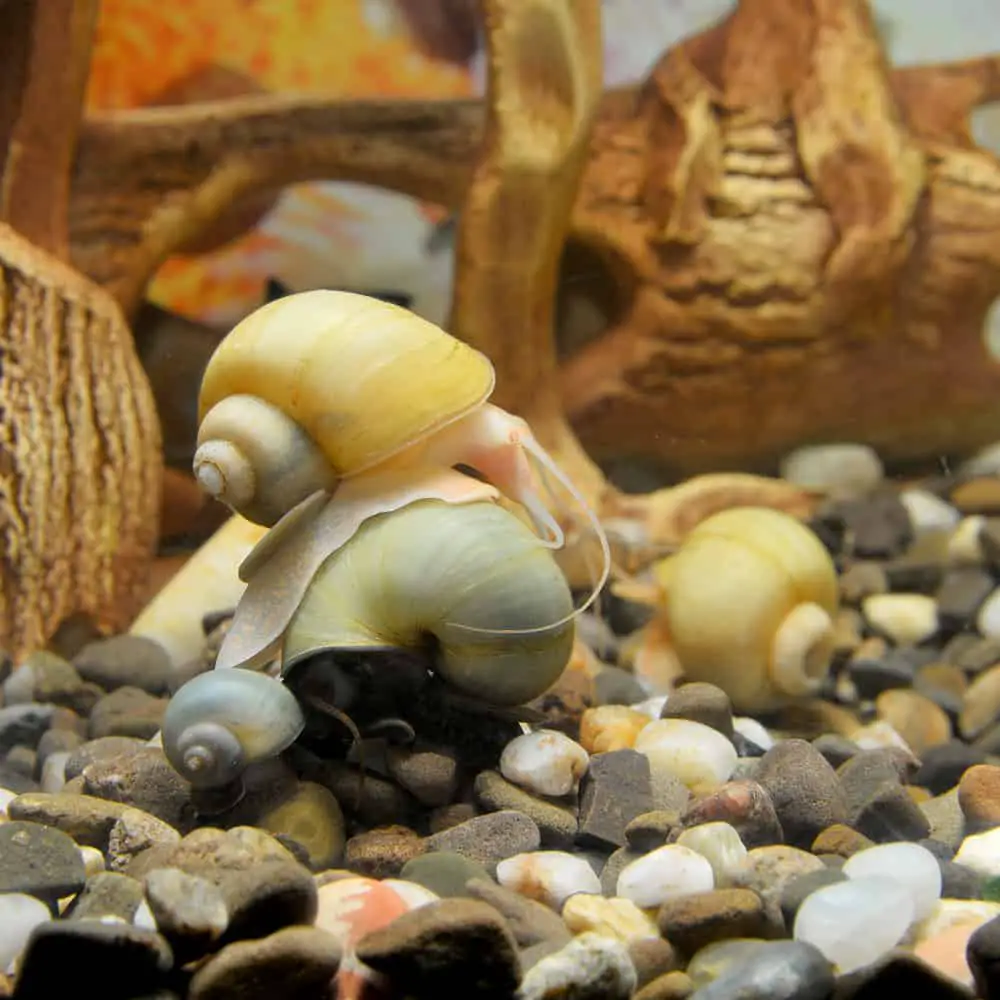
Snails do just appear in a fish tank – sort of. These sneaky pests’ eggs settle on live plants or float in the water in fish tanks. When you purchase a plant or fish, the eggs may come along in the package. They eventually grow into snails. Hence, you begin to see them appear in your fish tank.
In these cases, it seems like the snails suddenly appeared out of nowhere. However, the process is actually quite straightforward, but because you can’t always see the snails until they’re grown, it really does seem like they’re just there one day.
Let’s take a deeper look into how snails come along with the plants or fishes you buy:
New Fish
When you purchase fish or shrimp at a store, the store scoops up fish tank water along with the sea animal. This water probably contains minute snail eggs. Unfortunately, these eggs will not catch your eye.
Before you know it, by pouring the water from the fish store into your aquarium, you’ve brought a snail infestation upon yourself. So, pro-tip – DON’T put the water your fish travelled in into your aquarium.
New Plants
If you’ve suddenly got snails in your fish tank but haven’t purchased any new fish, it’s highly likely that they came along with the plants you purchased. Snails usually lay their eggs on plants. Sometimes they may be visible, but other times, they’re hidden under or between the leaves, making them hard to spot.
If you want to avoid getting snails into your fish tank, wash your plant thoroughly with chlorine and rinse it afterwards. You could also purchase Vitro plants. These are grown in laboratories in regulated atmospheres, making them a reliable and safe option.
Are Snails Good for a Fish Tank?

Snails are good for a fish tank if you get the right ones and avoid overpopulation. They keep your tank clean by feasting on algae, uneaten food, detritus, and dead fish and plants. In this way, snails prevent the biodegradation of products in a fish tank, which causes a decline in water quality.
Types of Snails.
Let’s dive into the different types of snails found in fish tanks:
Mystery Snails
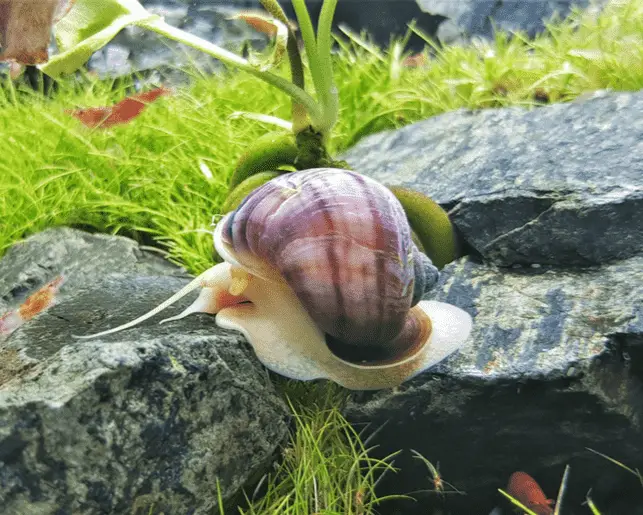
Mystery snails, scientifically known as Pomacea bridgesii, are also called Inca snails and are among the most popular apple snails for aquariums. They grow to be over 1.5 in (3.81 cm) in diameter.
These snails usually have a black or pinkish-orange body, with neon orange spots around the head area. Their shells are olive or tan with dark golden yellow, white, maroon, or blue stripes.
Mystery snails have a lifespan of three to four years. They make excellent scavengers as they gobble up algae and decaying plants.
Breeding mystery snails is simple, as they are gonochoristic, meaning there are male and female genders, and mating takes place between the two. The female has to leave the water to lay eggs.
These eggs appear like a honeycomb cluster on the tank’s wall, above the water, or under the lid. They hatch within two to three weeks, depending upon the water’s temperature.
Nerite Snails
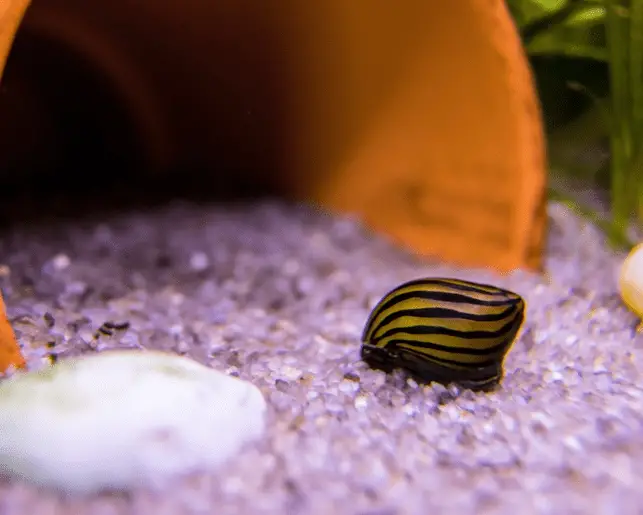
Nerites, scientifically known as Neritina spp., are pretty small – growing up to 1 in (2.54 cm) if kept in a healthy environment. You’ll find them in many colours and patterns, some even with horns. Aquarists find them beautiful.
Nerite snails feast on algae, uneaten fish food, dead plant matter, and other things on the bottom of the tank. Their waste is favourable for the digestive tracts of shrimps, making them essential for a shrimp tank’s ecosystem.
Breeding Nerites isn’t complex. Fortunately, their larvae require brackish or saltwater to develop, so they’re not likely to overpopulate a fish tank. They have a one-year lifespan.
Rabbit Snails
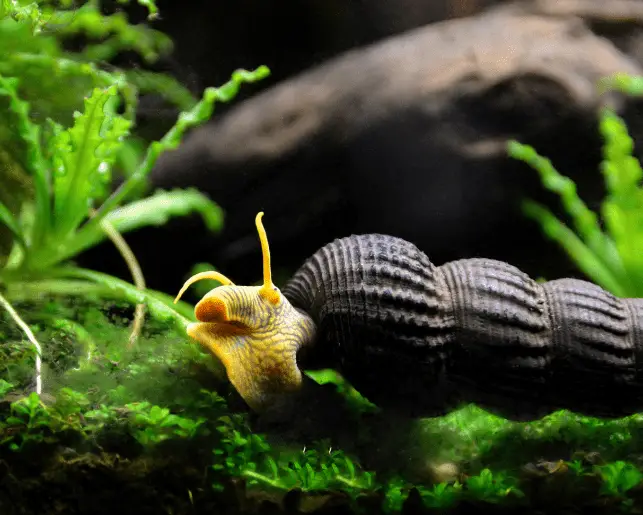
Rabbit snails or Tylomelania spp. come in exciting colours and have rabbit-like faces. They’re pretty large – you’ll find them growing up to 4 in (10.16 cm) in length. These snails have a lifespan of three years and are popular for bringing aesthetics into aquariums.
Rabbit snails prefer 20-gallon (75.7-liter) aquariums or larger, warm temperatures, and slightly alkaline water pH. They feed on decayed plant matter, soft algae, detritus, and fish foods found at the bottom of the tank.
Rabbit snails are gonochoristic and give birth to live and fully-developed young, bounded in a milky-white egg pod. These are born one at a time, and the snails have a slow reproduction rate, so you can pet several of them.
Malaysian Trumpet Snails
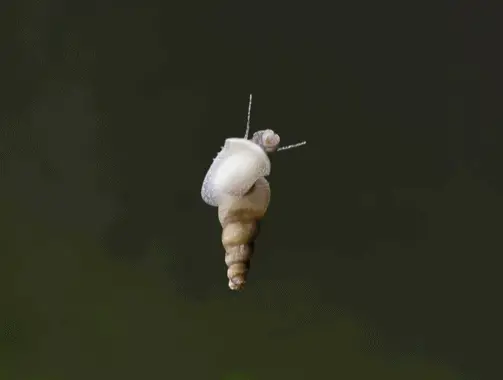
Malaysian Trumpet Snails (MTS) or Melanoides tuberculata are infamous for their fast reproduction rate. They are small, cone-shaped snails that prove to be excellent scavengers in any fish tank.
These snails don’t require a male to lay eggs. So if you bring one female MTS into your fish tank, it can give birth to many more females because of their prolific nature.
On the positive side, MTS seeks food in the substrate of aquariums. So they help clean substances and prevent anaerobic conditions in the tank. Also, these snails don’t eat plants.
How To Deal With a Snail Infestation.
You can deal with a snail infestation by keeping your fish tank clean and eliminating their food supply. Avoid overfeeding your fish, so there’s less food for snails. You can also add snail-eating species, such as assassin snails, loaches, puffers, etc., to the tank to drastically reduce the number.
Some people gravitate toward using chemicals to kill the snails in their aquarium. I’m here to advise you – please DON’T. These may do more harm than good by killing the fish or shrimp in the tank.
Instead, opt for introducing snail-eating species into your tank. You can also physically remove the snails or crush them so your fish can finish them off.
What Do Snail Eggs Look Like?
Snail eggs look like slimy bundles. They are brownish-grey in colour and have no particular shape because of their gelatinous structure. The slimy coating feels gummy. Use a torch to spot snail eggs, and make sure you look under leaves as they stick to any surface.
Why Is My Snail Hanging Out of Its Shell?
Your snail is probably hanging out of its shell because it’s dead. To confirm, you should perform a sniff test. A decaying snail gives off an unbearable stench. Also, touch the snail to see if it moves. If it doesn’t, then it’s most likely dead because snails are sensitive to external touch.
It’s important to note that dead snails produce ammonia, which can be toxic to aquatic life. You should remove them immediately upon finding them to prevent harm to your fish and plants.
Conclusion.
There you have it, all details regarding finding snails in a fish tank! Hopefully, this article has answered many of your questions about the snails in your fish tank, and you can make improvements through educated decisions.
Related Articles:
Why having a fish tank background is a good idea.
What causes algae in a fish tank and how do I get rid of it?

